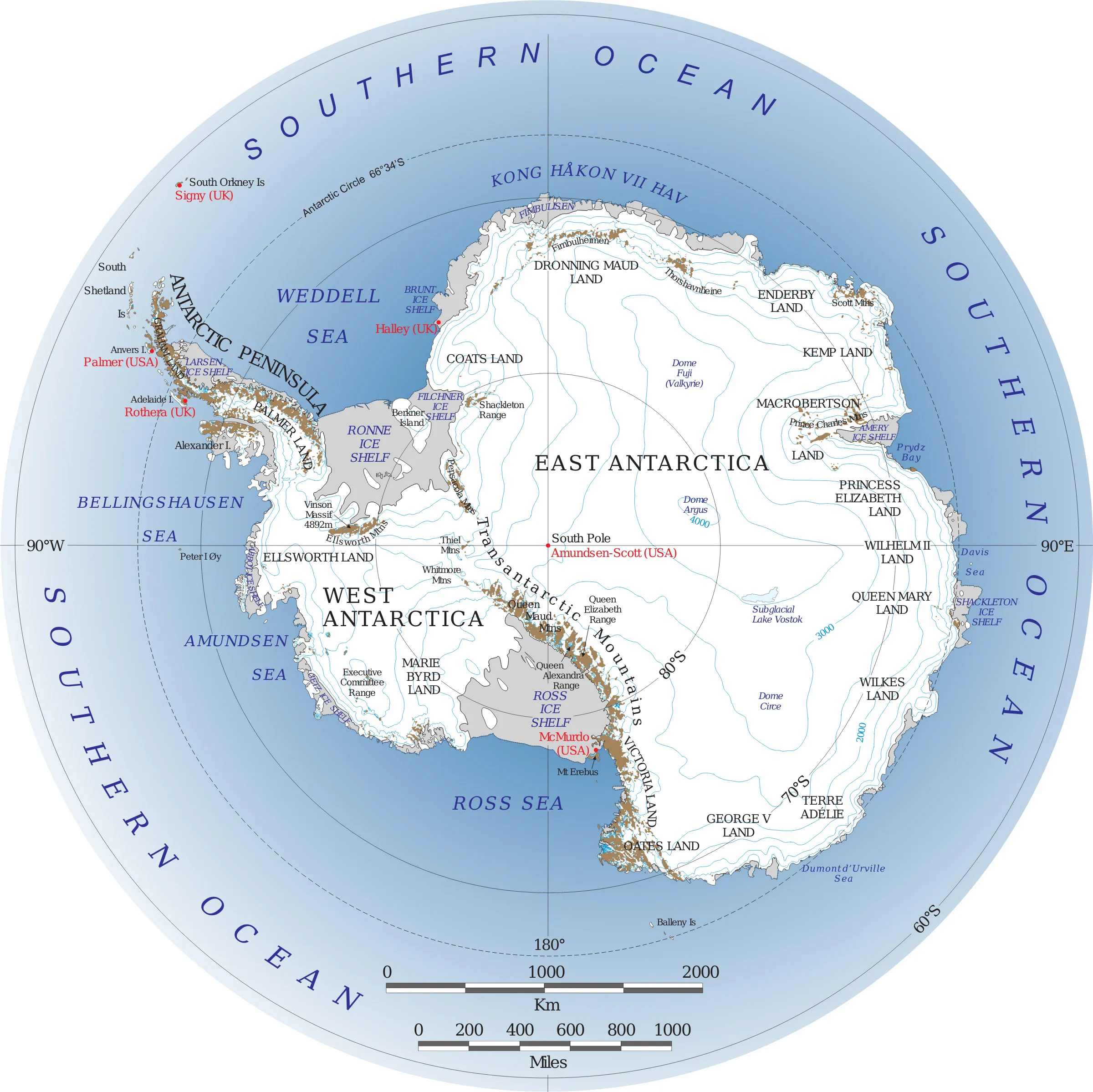Antarctica Case Study - Basic Knowledge + Threats
1/13
Earn XP
Description and Tags
AQA A-Level Geography
Name | Mastery | Learn | Test | Matching | Spaced |
|---|
No study sessions yet.
14 Terms
What is the climate of Antarctica?
Polar Desert
Average temps → -49°C to -89°C
Mean wind speed → 50mph (up to 200mph)
Low precipitation → less than 50mm/year
Location of antarctica and general information
→ South of 60°S (South Pole being at 90°S)
→ 60°S is the limit of the Antarctic treaty
→ 8million km² of land in 2 blocks
→ 99% is covered in an ice sheet
→ Coastline is fringed with ice shelves - largest are the Ross & Ronne ice shelves

What is the physical geography of Antarctica?
→ Mountainous and covered in glacial ice
→ High mountain peaks - too steep & winds don’t allow snow to accumulate - small areas of rock accumulate forming nuntaks
→ East/West divided by the Transatlantic Mountains - some peaks 4000m+
→ East is larger, thicker and older
→ Upwelling of cooler water brings in phytoplankton (food for krill)
→ Coastal areas (Especially west of the penninsula) have microclimatic conditions → warm enough for some land to remain glacier free

Key facts on the Antarctic Convergence Zone
32-48km wide (varies seasonally)
Cold flowing northward antarctic waters sink beneath antarctic waters
High productivity - especially krill
Natural boundary thats separates distinct hydrological regions
The largest global surface current is created called the Antarctic Circumpolar Current by the west wind drift
Threats to Antarctica - Whaling
By 1910 → provided 50% of the worlds catch
Commercial whaling ceased 1985 as stocks were so low
1986 - commercial whaling banned and effort made to try to increase their numbers
IWC created in 1949
Whaling specific facts
1904-1985 → 1.6million whales killed in the Southern Ocean
e.g. Fin whales: 725,000
Blue whale:
by 1973 fewer than 1,000 individuals
Current population estimation - 2,300 → 3,000
Population increasing at rate of 7% per year
Threats to Antarctica - Fishing
CCAMLR → aims of regulating the explotation rather than outright protection
Replaced whaling
Fishing ships detroy marine habitats and contaminate water by dumping waste
Krill oil - rich in omega-3 → used as a suppliment - leads to overfishing of krill
Fishing specific facts
Krill numbers have dropped by 80% since 1970s
498,000 metric tonnes krill caught in 2023
½ a million krill were fished for krill oil 2024
Threats to Antarctica - Climate Change
Long term threat
Significant ice retreat & collapse of ice shelves
If continues: krill populations devastated - affect food chain
West Antarctica’s sheel thinneer and more vulnreble
Habitat loss for many animals e.g. penguins
Climate Change specific facts
136 billion tonnes of ice lost per year
Thwaits Glacier - has lost 600 billion tons of ice between 1992 and 2017
3°C temp rise in the Antarctic Peninsula since 1950s
Threats to Antarctica - Mineral Extraction
Mineral deposits of coal, oil, maganese, titanium, gold and silver
not economically viable to mine
Significance of threat → little: commercial mining banned under the Antarctic Treaty
Threat is rising → global demand for some resources that are on antarctica
Pressure put on vast reserves - if given access = exploitation
2048 → treaty reevaluated & possibly resigned - worlds resources would be running out and more countries willing to exploit Antarctica
In future: might not be in agreement over the use of antarctica’s resources
Mineral deposits specific facts
Hydrocarbons thought to exist beneath the Ross and Weddell sea
Oil reserves in the Weddel Sea - 500 billion barrels - led to geopolitical tensions
Madrid Protocol - Article 7 - bans the mining of mineral resources exept for scientific purposes
Threats to Antarctica - Toursim → threats and reasons
The threat:
Can drop litter
disturb wildlife
tarmple plants
indroduce non-nativve species/diseases
Spillage of fuel ships
Reasons for tourism growth:
Media awareness, bucket list tourism, transport & tech developments, environmental curiosity
Tourism specific facts
1996/97 → 7,413 visitors
2022/23 → 71,346 visitors